Imagine soaring alongside a majestic bald eagle as it dives toward the water, capturing its powerful silhouette against the backdrop of a snow-capped mountain range. Or, picture yourself gliding silently above a herd of zebras traversing the vast African savanna, their stripes forming a mesmerizing pattern on the golden plains. These breathtaking wildlife encounters were once the exclusive domain of nature photographers on perilous expeditions. But today, thanks to the innovation of drones, capturing stunning wildlife imagery has become more accessible – and with the right approach, entirely ethical.
Unlocking New Perspectives: Drones Elevate Wildlife Photography
Drones have revolutionized wildlife photography, offering photographers a unique vantage point that was previously impossible. Gone are the days of lugging heavy camera equipment through treacherous terrain or relying on precarious observation blinds. Drones allow photographers to capture breathtaking aerial shots, showcasing the majesty of animals in their natural habitat from a respectful distance. Imagine capturing the intricate dance of a humpback whale breaching the ocean surface or revealing the intricate network of trails carved by elephants through a dense forest – all from a safe and non-intrusive perspective.
Ethical Considerations: Putting Wildlife First
The ability to capture stunning wildlife imagery with drones comes with a significant responsibility – the welfare of the animals themselves. Here at RCSdrone, we believe in ethical drone use that prioritizes the well-being of wildlife. Here are some essential guidelines to ensure your drone photography doesn’t disrupt or harm animals:
- Research is Key: Before heading out, thoroughly research the wildlife you intend to photograph. Understand their behavior, breeding seasons, and what might be perceived as a threat.
- Maintain a Safe Distance: Never fly your drone too close to animals. Observe their behavior and avoid causing any stress or disruption. Remember, a good wildlife photo is worth waiting for, and ethical practices often involve patience and observation.
- Respect Nesting Sites and Breeding Grounds: Avoid flying your drone near animal nesting sites or breeding grounds. These are sensitive areas where even minimal disturbance can have significant consequences.
- Be Mindful of the Noise: Drones can be noisy. Be mindful of the environment and avoid flying your drone during feeding times or periods of rest.
Follow Local Regulations: Always research and adhere to local drone regulations in the area you’re flying in. Many locations have specific restrictions regarding drone use near wildlife habitats.

Essential Drone Features for Wildlife Photography
Here is a quick guide to help when choosing a drone with the best features for capturing animals and scenery. Choose a drone with a high-quality camera, long flight time, and quiet operation. Consider models with obstacle avoidance features for safe flying in unpredictable natural environments (check out our buying guides at RCSdrone for recommendations!).
- Silent operation: Look for drones with noise-reducing propellers and motors for minimal disturbance.
- Long flight time: Capture extended footage or follow migrating animals with a drone offering a long battery life.
- High-resolution camera: Capture stunning details with a high-quality camera equipped with powerful zoom capabilities.
- Object tracking: Follow your subjects effortlessly with a drone that features advanced object tracking technology.
Pro wildlife photography tip: Schedule your flights for the golden hour (sunrise and sunset), when the natural light creates a warm and inviting atmosphere.
Embrace the beauty of nature with breathtaking drone photography. Explore the wonders of the wild world with RCSdrone as your guide, and let your camera become a voice for conservation. Remember, with great photographic power comes the responsibility to use it ethically and respectfully.




